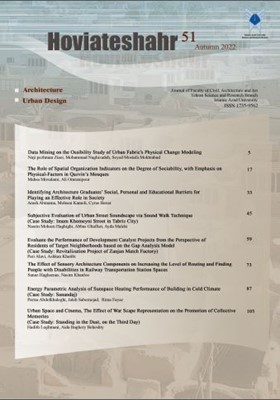Subjective evaluation of urban street soundscape via sound walk technique Case study: Emam Khomeyni street in Tabriz
Subject Areas : urban design
nasrin mohsen haghighi
1
,
Abbas Ghaffari
2
![]() ,
Ayda Maleki
3
,
Ayda Maleki
3
1 - Department of Urban Studies, faculty of architecture and urban studies, Tabriz Islamic art university
2 - Associate Professor, Faculty of Architecture and Urbanism, Tabriz Islamic Art University, Tabriz, Iran.
3 - Faculty of Architecture and urban studies, Tabriz Islamic art university
Keywords: urban landscape, sound walk, street, Soundscape,
Abstract :
The soundscape is one of the perceptual dimensions of the urban landscape, the quality of which depends on the pleasantness of the auditory perception of individuals. Different sonic potentials and, in general, the acoustic environment of any urban space is affected by the character and role of the area in the city. The central streets of the town are one of the urban spaces that, in addition to passing the various modes of transportation like light vehicles, heavy vehicles, motorcycles, buses, and BRT, include diverse land uses and functions and activities that it is both a transit space and a destination space for pedestrians. The acoustic quality of this space, which is affected by traffic flow and all activities that take place there, has a significant impact on the tendency of people to use the area and its pleasantness. In this study, an attempt was made to evaluate the quality of soundscape perception of pedestrians on Imam Street in Tabriz, which is the central main street of the city that embraces various architectural heritage sites and buildings. The sound walk method was used for the subjective assessment of 30 people (17 men and 13 women) based on the standard requirements of ISO12913-2. After giving the necessary training to the people, they were asked to walk from Fajr square to Shahid Beheshti Square, focusing on listening and evaluating the soundscape of the route at three station points. The results showed that nature-related sounds like bird songs, wind in the trees, and human sounds like conversations, kids playing sounds were assessed as pleasant, and the traffic-related sounds were assessed negatively. These unpleasant sounds were bus passing, motorcycles, horns, and sirens. In terms of overall soundscape quality, the route from Shariati Intersection to Saat square was evaluated as more eventful, memorable, chaotic, vibrant and pleasant. It seems this part's character and spatial organization have a meaningful effect on the pleasantness of the soundscape. The characteristics that differ from the two other factors are openness, different grades of the enclosure, the quality of porosity of the façade, diversity of the old buildings, sight to the heritage sites and buildings like Alishah Citadel, Saat palace and diversity in land use and functions like cinemas, fast foods and restaurants. When it was asked if the soundscape quality of space is according to your expectations, surprisingly, the majority of respondents answered that yes, and it was because the street is one of the main routes of the city, and it is normal to be chaotic and loud, but they admitted that this loudness shouldn't be related to unpleasant sounds. On the hand, results demonstrated that in similar traffic conditions, the factors affecting the perceptual pleasantness of individuals depend on the following factors: diversity of land use and activity (increasing diversity (spatial contrast) Leads to increased pleasantness, increased open and green space including diverse vegetation, reduced background noise level as well as architectural species of heritage value (the presence of valuable architectural heritage increases overall pleasantness).
_||_


